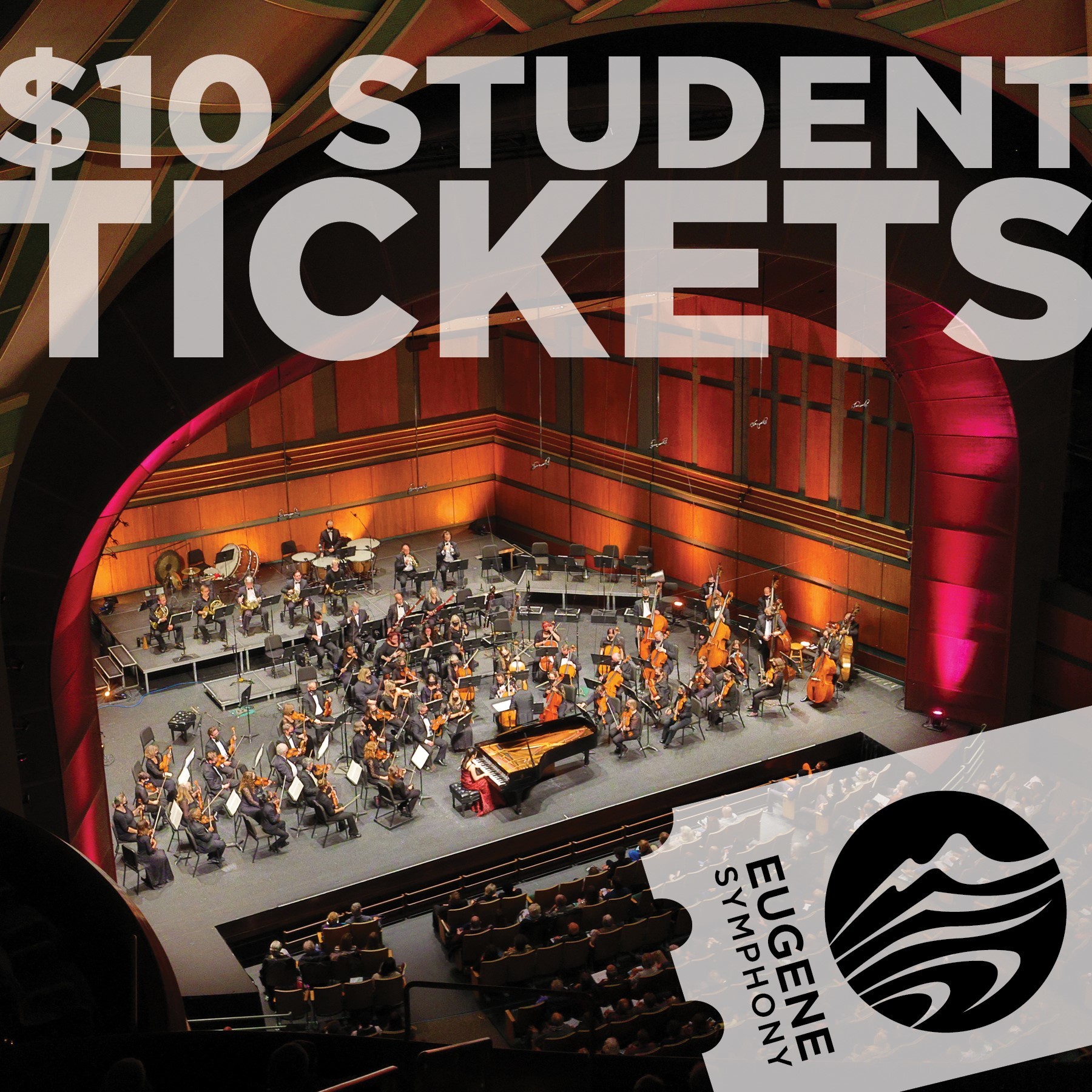Sat October 8 | 7:30 PM
Opening Night
We open our 2022/23 season with a Spanish flair, including Angélica Negrón's Me he perdido and Manuel de Falla's The Three-Cornered Hat.
TICKETSOctober 8, 2022 7:30 PM
Opening Night
Opening Night at Eugene Symphony is always electric…you’ll be introduced to the fresh sounds of First Symphony Project composer Angélica Negrón. Then you’ll hear George Gershwin’s jazz-infused and thoroughly American piano concerto, played by dynamic virtuoso Orion Weiss. Finally, Manuel de Falla’s evocative ballet score The Three-Cornered Hat, full of Spanish songs and flamenco-inspired dances, brings your evening to a dazzling close. Join us!
This concert will be broadcast on KWAX 91.1 on Tuesday, October 25, 2022 at 1:00 PM. Broadcasts underwritten in part by Eugene Safe Storage.
LEARN MORE
- Listen to the below Spotify playlist, curated by Music Director & Conductor Francesco Lecce-Chong, for inspiration and insight into the exciting first concert of our 2022/23 Season.
- Watch the below video of Music Director & Conductor Francesco Lecce-Chong introducing Opening Night's exciting offerings.
- Read our First-Timers Guide to brush up on orchestra vocabulary and find out what to expect from a concert at the Hult Center.
- Join us the night of the concert at 6:30 pm in the Studio at the Hult Center for a Guild Pre-Concert Talk — a deep dive into the context of the pieces performed by the orchestra. We will be returning to The Studio this season after being in the performance hall in 2021/22.
Learn more about Angélica Negrón
Puerto Rican-born composer and multi-instrumentalist Angélica Negrón writes music for accordions, robotic instruments, toys, and electronics as well as for chamber ensembles, orchestras, choir, and film. Her music has been described as “wistfully idiosyncratic and contemplative” (WQXR/Q2) while The New York Times noted her “capacity to surprise.”
Negrón has been commissioned by the Bang on a Can All-Stars, Kronos Quartet, loadbang, Prototype Festival, Brooklyn Youth Chorus, Sō Percussion, the Dallas Symphony Orchestra, National Symphony Orchestra, Opera Philadelphia, the Louisville Orchestra, and the New York Botanical Garden, among others. Angélica received an early education in piano and violin at the Conservatory of Music of Puerto Rico where she later studied composition under the guidance of composer Alfonso Fuentes.
She holds a master’s degree in music composition from New York University where she studied with Pedro da Silva and pursued doctoral studies at The Graduate Center (CUNY), where she studied composition with Tania León. Also active as an educator, Angélica is currently a teaching artist for New York Philharmonic’s Very Young Composers program. She has collaborated with artists like Sō Percussion, Lido Pimienta, Mathew Placek, Sasha Velour, Cecilia Aldarondo, Mariela Pabón & Adrienne Westwood, among others, and is a founding member of the tropical electronic band Balún. She was recently an Artist-in-Residence at WNYC’s The Greene Space working on El Living Room, a four-part offbeat variety show and playful multimedia exploration of sound and story, of personal history, and belonging. She was the recipient of the 2022 Hermitage Greenfield Prize.
Upcoming premieres include works for the Seattle Symphony, LA Philharmonic, NY Philharmonic Project 19 initiative, and multiple performances at Big Ears Festival 2022. Negrón continues to perform and compose for film.
Learn more about Orion Weiss
One of the most sought-after soloists and chamber music collaborators of his generation, Orion Weiss is widely regarded as a “brilliant pianist” (The New York Times) with “powerful technique and exceptional insight” (The Washington Post). With a warmth to his playing that outwardly reflects his engaging personality, Weiss has dazzled audiences with his passionate, lush sound and performed with dozens of orchestras in North America including the Chicago Symphony, Boston Symphony, Los Angeles Philharmonic, and New York Philharmonic.
Known for his affinity for chamber music, Weiss performs regularly with violinists Augustin Hadelich, William Hagen, Benjamin Beilman, and James Ehnes; pianists Michael Brown and Shai Wosner; cellist Julie Albers; and the Ariel, Parker, and Pacifica Quartets. As a recitalist and chamber musician, Weiss has appeared across the United States at venues and festivals including Sheldon Concert Hall, the Broad Stage, Seattle Chamber Music Festival, La Jolla Music Society SummerFest, the Schubert Club, Chamber Music Northwest, Bridgehampton Chamber Music Festival, Spivey Hall, and many more.
Weiss can be heard on the Naxos, Telos, Bridge, First Hand, Yarlung, and Artek labels in recordings such as The Piano Protagonists with The Orchestra Now led by Leon Botstein; Scarlatti’s Complete Keyboard Sonatas; a disc of Bartók, Dvorák, and Prokofiev; Brahms Sonatas with violinist Arnaud Sussmann; a solo album of J.S. Bach, Scriabin, Mozart, and Carter; and a recital disc of Rachmaninov, Beethoven, Schumann, Massenet, and Piatigorsky with cellist Julie Albers. In March 2022, First Hand Records released the first album of Weiss’s Arc Trilogy — Arc I: Granados, Janáček, Scriabin — a recording that explores the omens and anxiety of the tense world leading up to the first World War. Gramophone Magazine praised the album as “expansive, colourful, and texturally varied.” Arc II, featuring the music of Ravel, Brahms, and Shostakovich, will be released in late 2022.
A native of Lyndhurst, Ohio, Weiss attended the Cleveland Institute of Music where he studied with Paul Schenly, Daniel Shapiro, Sergei Babayan, Kathryn Brown, and Edith Reed. In February of 1999, Weiss made his Cleveland Orchestra debut performing Liszt’s Piano Concerto No. 1. The next month, with less than 24 hours’ notice, Weiss stepped in to replace André Watts for a performance of Shostakovich’s Piano Concerto No. 2 with the Baltimore Symphony Orchestra and was immediately invited to return for a performance of the Tchaikovsky Piano Concerto in that October. In 2004, he graduated from the Juilliard School, where he studied with Emanuel Ax.
Opening Night Program Notes
Eugene Symphony embarks on its 2022/23 Season with an electrifying Opening Night:
- A synthesis of new and old with First Symphony Project composer Angélica Negrón’s Me he perdido, an enthralling sonic journey featuring mechanical instruments
- George Gershwin’s swanky and jazz-inspired Piano Concerto in F, featuring dynamic pianist Orion Weiss
- A tour of Spain through folk songs and dances from Manuel de Falla’s ballet The Three-Cornered Hat to close the evening
ME HE PERDIDO
Angélica Negrón (b. 1981)
DURATION: Approximately six minutes
Puerto Rican-born composer and multi-instrumentalist Angélica Negrón is considered to be one of the most exciting composers working in the field today, pushing the boundaries of what is heard in concert halls around the world. Negrón has received commissions from leading organizations and performing groups in the United States and abroad, including the Dallas Symphony Orchestra, National Symphony Orchestra, Opera Philadelphia, and Kronos Quartet, with premieres on the horizon with the Seattle Symphony, Los Angeles Philharmonic, and New York Philharmonic.
Negrón composed Me he perdido (“I’ve Gotten Lost”) in 2015 while she was the Van Lier Emerging Composers Fellow of the American Composers Orchestra, premiering the piece at the organization’s SONiC Festival. Described by the composer as music for orchestra and a “mechanical percussion ensemble,” the piece showcases Negrón’s signature ethereal sound with orchestra and robotic instruments trading cascading musical figures and pulsing rhythmic lines.
Of the piece’s unique instrumentation, the composer said, “It was an interesting experiment as I originally conceived the mechanical ensemble as an extension of the percussion section of the orchestra and although that approach was still a part of the compositional process of the piece, the robotic instruments gradually revealed a dynamic life of their own that changed the way I wrote for them.” The music conjures the image of the cosmos, and gives listeners a sense of a journey through deep space.
SCORED: For two flutes, two oboes, two clarinets, two bassoons, four horns, two trumpets, two trombones, tuba, percussion, mechanical percussion played from a laptop computer, harp, a MIDI keyboard, and strings.
HISTORY: This is the first Eugene Symphony performance.
PIANO CONCERTO IN F
George Gershwin (1898–1937)
DURATION: Approximately 31 minutes
By the time he reached the age of 25, American composer George Gershwin had risen from an unknown songwriter, peddling ditties to record companies and department stores, to a nationally recognized composer of hit songs and Broadway shows, complete with a 1925 appearance on the cover of TIME magazine. His 1924 work with orchestra, Rhapsody in Blue, which is his most famous piece today, had become an instant sensation and was being performed across the United States. Additionally, it was sparking heated debate in the classical music world of the integration of the sounds of jazz into its hallowed halls that typically only housed the worshipped tones of Mozart and Beethoven.
Fueled by the piece’s notoriety and the idea that there is no such thing as bad publicity, the New York Symphony Society commissioned a full-scale piano concerto from Gershwin. “Many persons thought the Rhapsody was only a happy accident,” the composer wrote. “Well, I went out, for one thing, to show them that there was plenty more where that had come from.”
Gershwin began work on the Concerto in F in July of 1925, while also working on at least three Broadway musicals. Up to this point in his career, it was the most ambitious and intricate work for the orchestral stage he had attempted and the first work he had scored entirely on his own. Finished within four months, the piece premiered on December 3, 1925, with the composer himself at the piano with the New York Symphony. Gershwin would later call the first rehearsals and performances of the Concerto, “the peak of my highest joy.”
The work is self-assured in its style and vitality, with mood and atmosphere at the forefront of Gershwin’s intent. The first movement begins with pounding drums as horns set up a swaggering groove, punctuated by chattering woodwinds. The solo piano croons with an air of self-confidence, conversing with the orchestra rather than dominating it. Gershwin noted that the movement “employs the Charleston rhythm. It is quick and pulsating, representing the young, enthusiastic spirit of American life.”
The second movement comes in three large sections: the toe-tapping center theme is sandwiched between two slower outer segments featuring clarinets and a solo trumpet that conjures up the image of a smoke-filled bar at an ungodly hour. Gershwin described it as having a “poetic nocturnal atmosphere which has come to be referred to as the American blues…”
The third and final movement is cinematic in its intensity and dramatic nature, almost never flagging in its energy and brilliantly showcasing the virtuosity of the soloist.
SCORED: In addition to the solo piano, this work is scored for two flutes, piccolo, two oboes, English horn, three clarinets including bass clarinet, two bassoons, four horns, three trumpets, three trombones, timpani, tuba, timpani, percussion, and strings.
HISTORY: First performed by Eugene Symphony in December 1975 under the baton of Lawrence Maves and with Marlene Thal as soloist, and last performed in October 2013 under the direction of Danail Rachev and with Ian Parker as soloist.
THE THREE-CORNERED HAT
Manuel de Falla (1876–1946)
DURATION: Approximately 34 minutes
Spanish composer Manuel de Falla’s most well-known work, like many of the great works of art, was a product of fortune. Russian impresario Serge Diaghilev and his Ballet Russes, famous throughout the artistic world for their subversive premieres of Maurice Ravel’s Daphnis et Chloé (which Eugene Symphony will perform in May) and Igor Stravinsky’s The Rite of Spring, happened to be in Madrid during World War I in 1917 and chanced upon de Falla’s small music production called El corregidor y la molinera (The Magistrate and the Miller’s Wife). Taken by de Falla’s fiery score, filled with Spanish folk songs and dances, Diaghilev asked the composer to expand the small two-act play into a full-scale ballet, scored for a full orchestra. The original production of the The Three-Cornered Hat by the Ballet Russes, which toured around the world for years, had an artistic team that would prove to be legendary: the music by de Falla, choreography by famed dancer Leonid Massine, and set and costume design by de Falla’s fellow Spaniard Pablo Picasso.
The ballet tells the story of a beautiful woman who is preyed upon by the corrupt and scheming magistrate of her town, who wears the titular headwear and attempts to use his power and influence to assault her. The woman, along with her honest and resourceful husband, the miller, use their wits to outsmart and ultimately humiliate the scheming magistrate. The Three-Cornered Hat is laid out in two parts, the first beginning as an introduction with pounding timpani, fanfare brass, and shouts of “Ole!” A centerpiece of the first part is the “Dance of the Miller’s Wife,” a blazing fandango, featuring fluttering woodwinds and sweet strings.
The second part begins with “The Neighbors’ Dance,” based on the seguidilla, a quick Castilian dance characterized by lively footwork and restrained upper body movement. The climax of the ballet comes with the “Miller’s Dance,” in which the miller portrays both the character of a bull and bullfighter—the dance is a farruca, a form of flamenco. The music alternates between sultry solos in the woodwinds and rhythmic strings, which build into a frenzy to the end of the dance. The ballet closes with the “Final Dance,” a vibrant collage of colors that is written in the style of the jota, a dance that likely originated in a region of Spain called Aragon.
SCORED: For three flutes, two piccolos, two oboes, English horn, two clarinets, two bassoons, four horns, three trumpets, three trombones, tuba, timpani, percussion, harp, piano, celesta, and strings. A mezzo-soprano is also featured in two movements.
HISTORY: A suite from the ballet was performed by Eugene Symphony in September 2012 under the direction of Danail Rachev; this is the first complete performance.
Check out our signature cocktail: The Three Cornered Hat

Check out our signature cocktail, The Three Cornered Hat, inspired by Manuel de Falla’s evocative ballet score by the same name, full of Spanish songs and flamenco-inspired dances. This drink features rum, pineapple juice, and club soda. It's the perfect pairing for an electrifying night of music!
Enter Our Lottery
Are you feeling lucky? Enter the Eugene Symphony lottery for the chance to win two tickets to an upcoming concert! Fill out our form, and choose from a variety of our symphonic concerts that you would like to attend. Learn more here.
Health & Safety
The health and safety of Eugene Symphony audience members, musicians, and staff members has been and will always be our top priority. We strongly welcome and encourage patrons who wish to continue wearing masks while attending performances to do so. We want all of our attendees to feel comfortable and accepted in your choice. You take care of you, we'll take care of the music and ensuring that your experience attending a Eugene Symphony concert remains exceptional.
For the most up to date health and safety protocols for our concerts, visit our Eugene Symphony Safety page.
LOCATION: Hult Center for the Performing Arts


